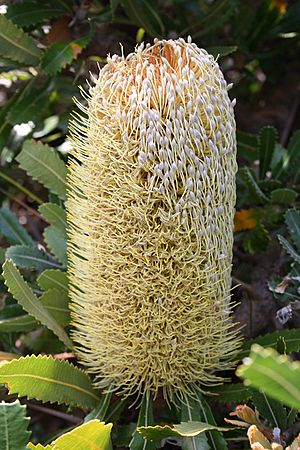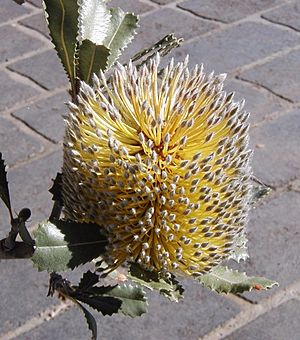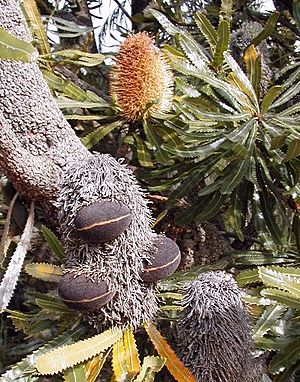Banksia subser. Banksia facts for kids
Quick facts for kids Banksia subser. Banksia |
|
|---|---|
 |
|
| Banksia serrata (Saw Banksia), the type species of Banksia. | |
| Scientific classification | |
| Kingdom: | |
| (unranked): | |
| (unranked): | |
| Order: | |
| Family: | |
| Genus: | |
| Subgenus: | |
| Series: | |
| Subseries: |
B. subser. Banksia
K.R.Thiele
|
Banksia subser. Banksia is a scientific name used for a specific group of plants within the larger Banksia genus. It was first used by a scientist named Kevin Thiele in 1996. However, another scientist, Alex George, later decided not to use this specific grouping in 1999.
Understanding Banksia Family Trees
Scientists use a method called cladistics to figure out how different plants are related to each other. It's like building a family tree for plants, grouping them based on shared features.
In 1996, Kevin Thiele and Pauline Ladiges did a cladistic study of Banksia plants. They found that some Banksia species, which were previously grouped separately, actually belonged together. This new, larger group included plants from what was known as Banksia series Banksia and Banksia series Crocinae.
This big group then naturally split into two smaller groups:
- One group included: B. ornata (Desert Banksia), B. serrata (Saw Banksia), and B. aemula (Wallum Banksia).
- The other group contained many more species like B. candolleana, B. sceptrum, B. baxteri, B. speciosa, B. menziesii, B. burdettii, B. victoriae, B. hookeriana, and B. prionotes.
How Banksias Are Grouped
Based on their study, Thiele and Ladiges created a new way to classify these Banksia plants. They kept the larger group as Banksia series Banksia. Then, they divided it into two subseries, following their cladistic findings.
The first subseries was named B. subser. Banksia. It included the three species found in their first small group:
- B. ornata (Desert Banksia)
- B. serrata (Saw Banksia)
- B. aemula (Wallum Banksia)
The type species for this subseries, which is like the main example for the group, is B. serrata. All three of these species grow naturally along the east coast of Australia.


The other species from their study were placed in a different subseries called B. subser. Cratistylis .
Here's a simplified look at how Thiele and Ladiges organized some of the Banksia plants:
- Banksia
- B. subg. Isostylis (3 species)
- B. subg. Banksia
- B. ser. Tetragonae (4 species)
- B. ser. Banksia
- B. subser. Banksia
- B. subser. Cratistylis (9 species)
This way of classifying Banksia was used for a few years. However, in 1999, Alex George published his own updated classification for the Flora of Australia book series. He looked at some of the new information from Thiele and Ladiges but decided to go back to a classification similar to his earlier one from 1981. In his new system, he did not use the B. subser. Banksia grouping.
New Discoveries About Banksias
Since 1998, a scientist named Austin Mast has been studying the DNA of Banksia plants. His research suggests that the family tree of Banksia is quite different from what scientists thought before.
Even though B. subser. Banksia is a natural group (meaning its members are closely related), Mast's studies show that it's not as closely related to other plants in B. ser. Banksia as once believed. Instead, it seems to be more closely related to groups like B. ser. Ochraceae and B. ser. Prostratae.
In 2007, Mast and Thiele started to rearrange the Banksia genus. They moved another group of plants called Dryandra into Banksia. They also created a new subgenus called B. subg. Spathulatae for species with spoon-shaped cotyledons (the first leaves of a seedling). All the plants in the old subseries Banksia belong to Mast and Thiele's B. subg. Banksia. Scientists are still working on a complete new classification system as they finish studying the DNA of all these plants.

